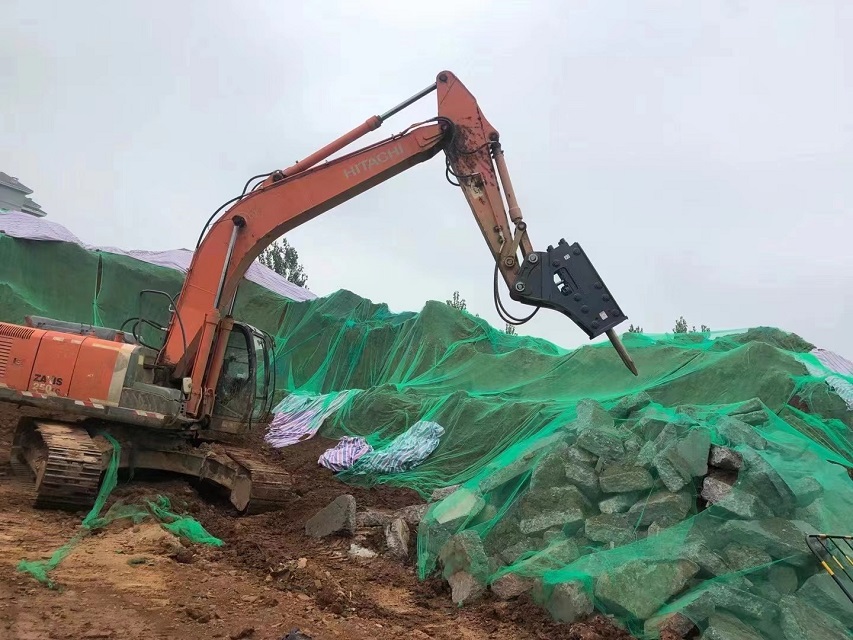
The Application of Hydraulic Breakers in the Construction Demolition Industry
Introduction
The construction demolition industry relies on powerful and efficient tools to break down concrete, rock, and other hard materials. Among these
tools, hydraulic breakers (also known as hydraulic hammers or demolition hammers) play a crucial role in ensuring fast, precise, and safe
demolition.
This article explores the applications, benefits, and best practices of using hydraulic breakers in construction demolition, helping contractors and
project managers make informed decisions.
What is a Hydraulic Breaker?
A hydraulic breaker is a heavy-duty attachment mounted on excavators, skid steers, or backhoes. It uses hydraulic power to deliver high-impact
blows, breaking through tough materials like:
· Concrete
· Asphalt
· Rock
· Reinforced structures
These tools are essential in demolition, mining, quarrying, and trenching operations.
Key Applications of Hydraulic Breakers in Demolition
1. Building Demolition
Hydraulic breakers are widely used in structural demolition, including:
· High-rise buildings – Controlled demolition of floors and walls.
· Bridges & overpasses – Breaking down concrete supports.
· Industrial facilities – Demolishing factories, warehouses, and chimneys.
Their precision reduces collateral damage, making them ideal for urban demolition projects.
2. Road & Pavement Removal
Breaking up old asphalt and concrete pavements is a common use for hydraulic breakers. They help in:
· Highway repairs
· Airport runway renovations
· Urban road maintenance
3. Trenching & Foundation Work
When excavating rocky terrain or removing old foundations, hydraulic breakers:
· Break boulders for easier removal
· Demolish old footings for new construction
· Prepare sites for utility installations
4. Mining & Quarrying
In mining operations, hydraulic breakers assist in:
· Primary rock breaking
· Secondary reduction of oversized rocks
· Tunneling and underground excavation
5. Secondary Reduction of Concrete Debris
After initial demolition, large concrete chunks often need further breaking for recycling. Hydraulic breakers make this process efficient.
Advantages of Using Hydraulic Breakers in Demolition
1. High Efficiency & Speed
· Faster than manual demolition or traditional jackhammers.
· Reduces project timelines significantly.
2. Precision & Control
· Operators can target specific areas without damaging surrounding structures.
· Ideal for selective demolition in tight spaces.
3. Versatility
· Compatible with various carriers (excavators, skid steers, etc.).
· Different sizes available for light-duty to heavy-duty tasks.
4. Cost-Effectiveness
· Low maintenance compared to explosive demolition.
· Reduces labor costs by minimizing manual work.
5. Safety Improvements
· Minimizes flying debris risks.
· Reduces worker exposure to hazardous environments.
Choosing the Right Hydraulic Breaker for Demolition
Selecting the appropriate breaker depends on:
1. Carrier Machine Compatibility
· Excavator size (mini, mid-size, large) determines breaker weight and impact energy.
· Hydraulic flow & pressure must match the breaker’s requirements.
2. Job Requirements
· Light-duty breakers (500-1,500 ft-lbs) – Thin concrete, asphalt.
· Medium-duty (1,500-3,500 ft-lbs) – Reinforced concrete, medium rock.
· Heavy-duty (3,500+ ft-lbs) – Large-scale demolition, boulder breaking.
3. Durability & Maintenance
· Look for heat-treated steel construction for longevity.
· Regular greasing and inspections prevent wear.
4. Noise & Vibration Reduction
· Modern breakers feature silenced technology for urban projects.
· Anti-vibration systems protect operators.
Best Practices for Hydraulic Breaker Operation
To maximize efficiency and lifespan:
· Proper Mounting – Ensure correct installation to prevent damage.
· Avoid Blank Firing – Don’t operate the breaker without contact with material.
· Use the Right Tool – Select appropriate chisel (point, flat, moil) for the job.
· Regular Maintenance – Check hydraulic lines, lubricate, and replace worn parts.
· Operator Training – Skilled handling improves safety and productivity.
Conclusion
Hydraulic breakers are indispensable tools in the construction demolition industry, offering speed, precision, and cost-efficiency. Whether
demolishing buildings, breaking pavement, or preparing mining sites, these powerful attachments enhance productivity while ensuring safety.
By selecting the right breaker and following best practices, contractors can optimize performance and extend equipment life, making them a smart
investment for any demolition project.
Need a Hydraulic Breaker for Your Next Project?
Explore high-performance demolition breakers designed for durability and efficiency. Contact us!




















